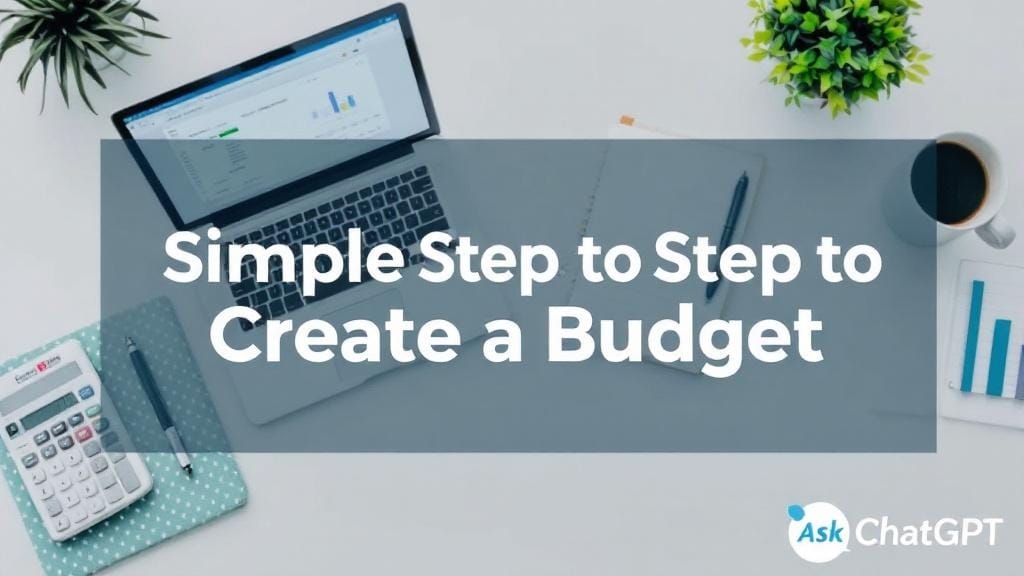Creating a budget can seem overwhelming, especially if you’re just starting out on your financial journey. However, budgeting is one of the most effective tools you can use to take control of your money and secure your financial future. Whether you’re looking to save for a big purchase, reduce debt, or simply track your spending, a budget is the foundation for achieving your financial goals.
In this post, we’ll cover simple steps for creating a budget that you can stick to. These actionable tips are designed for beginners but can benefit anyone who wants to improve their money management skills. So, let’s dive into the basics of creating a financial plan that works for you.
Why is Budgeting Important?
Before jumping into the steps to make a budget, let’s take a moment to understand why budgeting is crucial for financial success. A budget allows you to:
Track spending: It helps you understand where your money goes each month and whether you’re spending more than you earn.
Set financial goals: A budget makes it easier to set and meet short-term and long-term financial goals, such as saving for a vacation or paying off debt.
Build savings: With a clear budget, you can allocate a portion of your income to savings, helping you create an emergency fund or invest for the future.
Avoid debt: By managing your money properly, you can prevent overspending and accumulating unnecessary debt.
Step 1: Understand Your Income and Expenses
The first and most important step when creating a budget is to have a clear understanding of your monthly income. This includes your salary, any side gigs, or other sources of regular income.
Track Your Income:
Write down your net income (after taxes), as this is the actual amount you have to work with.
Include any other sources of income, such as child support, rental income, or freelance earnings.
Track Your Expenses:
Make a list of all your monthly expenses, including fixed expenses (rent, mortgage, utilities) and variable expenses (groceries, entertainment, dining out).
Don’t forget to factor in occasional expenses like gifts, holidays, or annual subscriptions.
By understanding both your income and expenses, you’ll have a clear view of your spending habits, which is essential for any personal budget creation.
Step 2: Set Financial Goals
Before diving into the details of your budget, it’s important to have clear financial goals. These goals can be short-term (like paying off credit card debt) or long-term (like buying a home or building a retirement fund).
Some common goals include:
Saving for emergencies
Paying down debt
Building a retirement fund
Saving for big purchases (like a vacation or home renovation)
Example:
Let’s say you want to save $5,000 for an emergency fund within the next 12 months. Your goal will be to save about $417 per month. This will be a priority in your simple budget plan.
Step 3: Categorize Your Spending
When creating a budgeting strategy for saving, it’s helpful to break down your expenses into categories. This will allow you to see exactly where your money is going and where you can cut back.
Here are some common categories:
Essentials:
Housing (rent, mortgage)
Utilities (electricity, water, gas)
Transportation (car payment, gas, insurance)
Non-Essentials:
Dining out
Entertainment (Netflix, movies, etc.)
Subscriptions (gym, magazines, online services)
Savings and Debt Repayment:
Emergency fund
Retirement savings (401k, IRA)
Credit card payments or loan repayments
By categorizing your expenses, you’ll be able to see where you can make adjustments to improve your financial planning.
Step 4: Choose a Budgeting Method
There are various budgeting methods that can work for different people. The key is to find one that fits your lifestyle and helps you stick to your budget. Here are a few popular budgeting strategies to consider:
1. The 50/30/20 Rule:
This method is simple and divides your income into three categories:
50% for needs: Essential expenses like rent, utilities, and groceries.
30% for wants: Non-essential items like dining out, entertainment, and shopping.
20% for savings and debt repayment: Money to put towards your emergency fund, retirement savings, or paying off debt.
2. The Zero-Based Budget:
With this method, every dollar of your income is assigned a specific task—whether it’s for spending, saving, or investing. The goal is to ensure that your income minus expenses equals zero by the end of the month.
3. The Envelope System:
This is a cash-based method where you divide your money into envelopes for different categories (e.g., food, entertainment, etc.). When the envelope is empty, you stop spending in that category for the rest of the month.
4. The Pay-Yourself-First Method:
This strategy involves automatically setting aside a percentage of your income for savings or investments before spending anything else. It’s a great way to prioritize savings.
Example:
For someone just starting out with budgeting, the 50/30/20 rule is often the easiest method to follow. It’s simple and allows you to prioritize essential needs, while still making room for fun and savings.
Step 5: Track Your Spending Regularly
Now that you’ve set up your budget, it’s time to track your spending. Expense tracking methods help you stay on track and ensure that you’re not overspending.
Tips for Tracking:
Use budgeting tools: Tools like Mint, YNAB (You Need a Budget), or PocketGuard can help you easily track your income and expenses.
Keep a spending journal: Write down your daily expenses to see where your money is going.
Set reminders: Use calendar alerts or apps to remind you of upcoming bills or financial goals.
Step 6: Adjust Your Budget as Needed
A budget is not a one-size-fits-all solution, and it’s okay to adjust it if things change. Life happens—emergencies arise, and unexpected expenses can pop up. When this happens, don’t be discouraged. Instead, adjust your budget to account for the change and ensure that your goals are still achievable.
For example, if you find that your transportation costs have increased, you can adjust by cutting back on non-essential spending, like entertainment, or find ways to reduce your fuel expenses.
Budgeting Tips for Beginners
Start small: If you’re new to budgeting, don’t try to change everything at once. Begin by tracking your expenses and making small adjustments.
Use an easy budget template: Many free online templates are available to help you organize your budget. Use one that fits your needs and makes the process easier.
Set realistic goals: When you’re creating a financial plan, make sure your goals are achievable. Setting unrealistic goals can lead to frustration.
Celebrate milestones: Every time you meet a financial goal (whether it’s saving for an emergency fund or paying down debt), take a moment to celebrate your progress.
FAQs
1. How do I create a budget if I have irregular income?
If you have irregular income, try to base your budget on your average monthly income over the past few months. You can also use the 50/30/20 rule to ensure that you’re prioritizing essential expenses, saving for emergencies, and setting aside money for fun.
2. How can I stick to my budget?
Sticking to your budget requires financial discipline. Use budgeting tools, track your spending regularly, and set realistic goals that are attainable within your income range. It’s also helpful to review your budget each month and adjust if needed.
3. How do I track my spending without getting overwhelmed?
Start by tracking your expenses for just a week or two. Use budgeting apps to make it easier, or keep a simple spending journal. Gradually, you’ll become more comfortable with tracking, and it will feel less overwhelming.
4. What’s the best budgeting tool for families?
There are several budgeting tools for families, but a great option is EveryDollar, which allows for easy tracking of household expenses and joint budgeting. Mint and YNAB are also popular choices for families who want to get a clear picture of their finances.
5. How can I save money on groceries while sticking to my budget?
Plan your meals ahead of time, make a shopping list, and avoid impulse buys. Look for discounts or consider buying in bulk for items you use regularly. Tracking your spending on groceries is also an effective way to cut costs.
6. How can I set financial goals if I have debt?
When managing debt through budgeting, start by setting a goal to pay off high-interest debt first. Once that’s done, allocate more money toward building an emergency fund and saving for the future.
7. How do I budget for emergencies?
In your budget, aim to allocate at least 20% of your income to savings, including an emergency fund. This will help cushion you in case of unexpected events, like medical expenses or car repairs.








Comments (0)